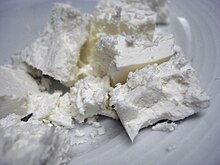 Manouri | |
| Aging time | 60 days |
|---|---|
Manouri (Greek: μανούρι) is a Greek semi-soft, fresh white mixed milk-whey cheese made from goat or sheep milk[1] as a by-product following the production of feta.[2] It is produced primarily in Thessalia and Macedonia in central and northern Greece.[3]
Manouri is creamier than feta, because of the addition of cream to the whey. It has about 36-38% fat, but only 0.8% salt content, making it much less salty than feta. It is used in salads, pastries, or as a dessert cheese. It can be substituted for cream cheese in dishes such as cheesecake.[2]
Manouri was featured in the Washington Post: "Manouri’s light aroma is slightly sour, similar to that of fresh yogurt, but it lacks yogurt’s (or feta’s) acidity. Instead, it has a clean, subtle nutty flavor with a bit of sheepiness and the barest hint of tang. What really elevates the cheese, though, is its texture."[4]
See also
[edit]- List of cheeses
- Mizithra - Another Greek sheep cheese with very similar flavor, but more dry
References
[edit]- ^ "Manouri - Cheese.com". www.cheese.com. Retrieved 26 May 2017.
- ^ a b "Greek Manouri Cheese -- How It's Made and How to Cook With It". Archived from the original on 6 April 2015. Retrieved 26 May 2017.
- ^ "Manouri / Manoypi". www.cheeselibrary.com. Archived from the original on 18 October 2019. Retrieved 26 May 2017.
- ^ "All We Can Eat - Say Cheese: A whey with manouri". Retrieved 26 May 2017.
- ^ EU Manouri Profile (accessed 23 May 2009)
Well, that’s interesting to know that Psilotum nudum are known as whisk ferns. Psilotum nudum is the commoner species of the two. While the P. flaccidum is a rare species and is found in the tropical islands. Both the species are usually epiphytic in habit and grow upon tree ferns. These species may also be terrestrial and grow in humus or in the crevices of the rocks.
View the detailed Guide of Psilotum nudum: Detailed Study Of Psilotum Nudum (Whisk Fern), Classification, Anatomy, Reproduction